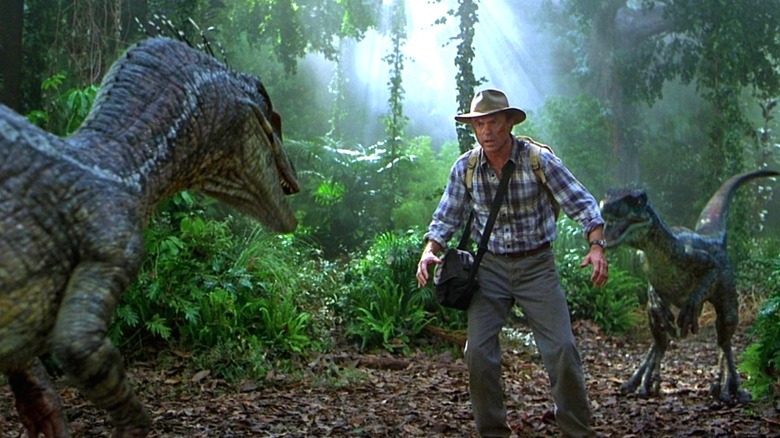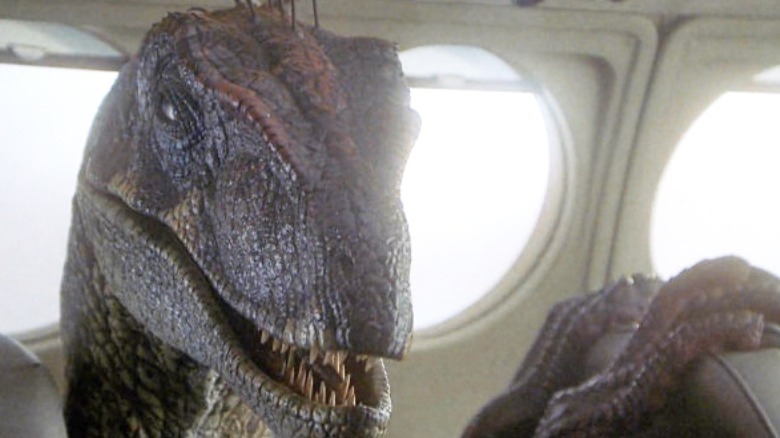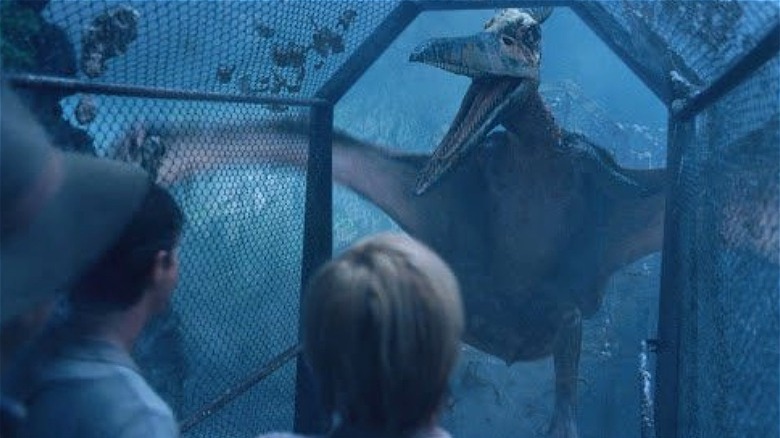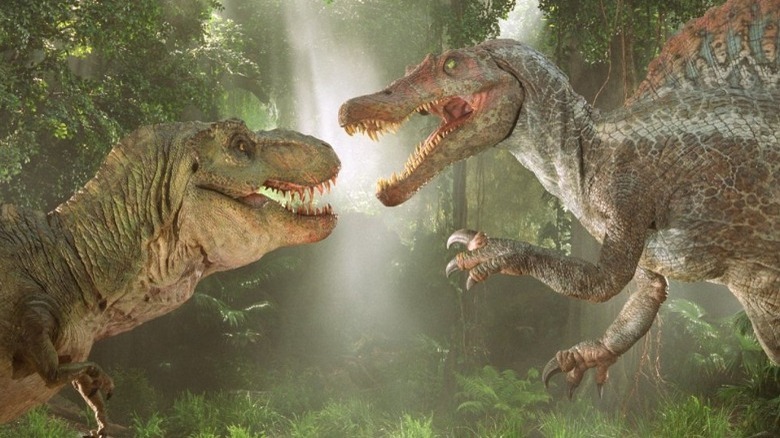The Behind-The-Scenes Struggle That Made Jurassic Park III 'A Living Hell'
"Jurassic Park III" is the awkward, B-movie black sheep of the blockbuster dinosaur franchise. Some say it's the worst one in the series, while even its fans acknowledge that it has no shortage of brazenly ridiculous moments. There's a good reason for the strange, rushed feel of "Jurassic Park III," though, and it arguably makes the odd mess of a movie even more interesting. Alas, the threequel was doomed to the Hollywood nightmare of not having a completed final draft of a screenplay during filming.
The plot of "Jurassic Park III" brought back Sam Neill as Dr. Alan Grant from the first film, using a familiar face in a similar fashion as Jeff Goldblum returning as Dr. Ian Malcolm in "The Lost World: Jurassic Park." The problem is, as director Joe Johnston himself has pointed out, it's difficult to come up with a reason for those that experienced the horrors of the first film to return. That contentious story element would curse the script-writing process and make Johnston's experience on set a spinosaurus-sized point of stress.
The Buchman draft
The on-set headaches of "Jurassic Park III" began with a script written by Peter Buchman. Buchman's draft revolved around two parallel plots that saw the dinosaurs escaping to the mainland as Dr. Grant joined a team on Isla Sorna, the breeding area from the second film. In this version, Dr. Grant makes a deal with a U.S. State Department representative to fund a velociraptor research station on the island. He agrees to testify at a hearing about mysterious dinosaur attacks in Costa Rica in order to receive research rights and, as an added bonus, accompanies a wealthy businessman's family on a sightseeing tour of Isla Sorna for a healthy donation.
It's easy to see why both Johnston and executive producer Steven Spielberg weren't happy with this version. Grant's reasons for returning to the world of Jurassic Park undermine the trauma of his initial journey, besides making him seem selfish and sleazy. To Johnston, the problem was that it was obvious that no one could come up with a straightforward reason for Grant's return to danger. In an interview with IGN that was published at the time of the film's release in July 2001, Johnston explains:
"The major problem with that script was in selling the audience on the return of paleontologist Alan Grant... to the island. The story we were getting ready to shoot was much more complicated; it was just too much, with all these tortured convolutions to get Grant back there."
A whirl of rewrites
The rest of Buchman's draft followed the final cut of "Jurassic Park III" more closely, besides for the eventually scrapped mystery B-plot in which the State Department rep investigates the killings on the Costa Rican mainland. The sequence in the InGen dino-breeding lab was originally longer with more velociraptor action, as was the case with the aviary sequence and the pterodons. In the end, the U.S. government bombs the island and Grant hides in the jungle, unable to abandon the place for some reason, despite it being a source of death and misery.
Johnston and Spielberg rejected Buchman's script just five weeks before the start of the shoot, when $18 million of the budget had already been spent complete with storyboards and a full shooting schedule. David Koepp, one of the writers of the first two "Jurassic Park" films, helped salvage the story and suggested that Grant should be helping to look for a family's lost son, a much simpler and humbler reason for the paleontologist to travel to Isla Sorna. Writing partners Alexander Payne and Jim Taylor, hot off the success of "Election," re-wrote Buchman's script with Koepp's idea in mind. To muddle the process even further, Buchman returned to revise the rewrite. If this all sounds confusing, that's because it is.
There was no final
The real truth, according to Johnston, was that there was no actual final draft completed when it was time to start shooting. All that revision work was essentially a "first act," according to Johnston, and Buchman's original set pieces in the middle portion of the film are still present, albeit shortened down. After all, $18 million couldn't go to waste. Johnston explains the headache-inducing conditions that showed just how much of a mess the script was during the actual filming:
"Sometimes we were writing the things that we were going to be shooting that afternoon. It's stupid. The only good thing about it is that it gives you the freedom to decide what you're going to do as you go along."
If "Jurassic Park III" ever seemed suspiciously strung together, it's because the production was succumbing to Dr. Malcolm's chaos theory. Despite a host of writers working on the material, the short-notice major changes to the script and the pressures to shoot previously unwritten material made the experience a "living hell," as the director puts it. Although Johnston could complete the film, much to his dismay no one seemed to ask if he should.



